A Brief History Of Cosmetic Breast Enhancement/Implants – Part 2: 2006 – 2011 And Beyond!
2006 – 15 years of follow-up research on silicone implants (following the FDA “ban” of 1992) shows that there is no scientific evidence to support any link between silicone implants and: breast cancer, connective tissue disorders, collagen-vascular disorders, rheumatoid arthritis, lupus, any neurological disease, or any known systemic health problem. The FDA issues formal approval for the newly redesigned silicone implants but the approval is contingent upon, and pending the final results of mandated ongoing research (“post-approval studies”) which will continue for approximately 10 years ( i.e. concluding about 2016).
2008 – The number of breast augmentation procedures in the USA exceeds the number of liposuction procedures for the first time. In the years that follow, breast augmentation is consistently either #1 or #2 in popularity.
2009 – Miss USA Pageant officials admit that they actually paid for the breast implant augmentation surgery for a contestant, Miss California, Carrie Prejean, who won the title of Miss USA.
2010 – Actress Heidi Montag fully informs the media in grand scale about her recently completed long list of cosmetic procedures, all performed at once; including “Double G” breast implant augmentation. A national debate is re-ignited over the ethics, problems and controversy involved in the decisions to create “excessively large” breasts and in the safety or advisability of having “multiple surgical procedures at once”. Tragically, her surgeon, Dr. Frank Ryan, dies in a car crash (believed to be caused by texting while driving) about 8 months later.
2011 – FDA issues a press release in January stating that an extremely rare tumor known as ALCL (Anaplastic Large Cell Lymphoma), may develop in the long-term scar tissue (i.e. the capsule) around breast implants. ALCL is not a form of breast cancer, but a rare form of Non- Hodgkin’s lymphoma, which generally occurs in children and men and has a yearly incidence of ~1/500,000. ALCL of the breast is even more rare with a yearly incidence of ~3 /100 million women. The FDA raised their concerns (a “Safety Signal”) to the public because of long-term accumulated data which seemed to indicate an increased incidence of ALCL in women with implants: ~60 incompletely confirmed cases out of the ~10 million women worldwide with implants. This represents a yearly incidence of ~1 per million. (Lightning strikes of people have a yearly incidence of ~2 per million.) Symptoms associated with ALCL: severe swelling, pain, and breast asymmetry. The investigation and research into this is active and ongoing. Public debate on implant safety revived; FDA requests that there be product labeling changes.
The present and/or future?
Fat injection/sculpting and stem cells – increasing in use and acceptance for the breasts (and for areas such as the face, the hands, scars, buttocks).
External, “reverse” tissue expansion (e.g. “Bravage” bra) devices, combined with fat injection/sculpting are under study and gaining favor.
Synthetic, large volume, biologically compatible injectable “fillers”(e.g. “Macrolane”) are under study.
An air-filled honeycomb design implant (Ami Glicksman, Israel).
Multiple, nestled, saline-filled silicone shells (Robert Hamas, Dallas).
“Micro-implants”: hundreds of raisin-like silicone pouches (William Brennan, Louisiana)
Dr. Lyle Back is originally from New York City, receiving his medical and surgical training at Rutgers Medical School, Cooper Hospital – University Medical Center, and Ohio State. He is Board Certified in General Surgery (ABS) and Plastic Surgery (ABPS). He specializes in the full range of the most modern and state of the art cosmetic surgery procedures for the breasts and non-surgical cosmetic enhancement techniques available today.
